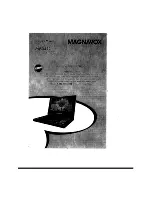
4
Remote Programming Reference
Sequenced Waveforms Control Commands
4-35
Table
4-5, Sequence Control Commands
Keyword
Parameter Form (Default in Bold)
Notes
[:SOURce]
:SEQuence
[:DATA]
<data_array>
:ADVance
AUTOmatic | STEP | SINGle | MIX
AUTO
:SELect
1
to
10
1
:DEFine
<step>,<seg_number>,<repeat>,<adv_mode>,<sync_bit>
:DELete
:NAME
1
to
4096
:ALL
:SYNC
[:TYPe]
BIT
|
LCOMplete
LCOM
SEQuence#<header><binary_block>
Description
This command will build a complete sequence table in one binary download. In this way, there is no need to
define and download individual sequencer steps. Using this command, sequence table data is loaded to the
5251 using high-speed binary transfer in a similar way to downloading waveform data with the trace
command. High-speed binary transfer allows any 8-bit bytes (including extended ASCII code) to be
transmitted in a message. This command is particularly useful for long sequences that use a large number
of segment and sequence steps. As an example, the next command will generate three-step sequence with
16 bytes of data that contains segment number, repeats (loops) and mixed mode flag option.
SEQuence#216<binary_block>
This command causes the transfer of 16 bytes of data (2-step sequence) to the sequence table buffer. The
<header> is interpreted this way:
•
The ASCII "#" ($23) designates the start of the binary data block.
•
"2" designates the number of digits that follow.
•
"16" is the number of bytes to follow. This number must divide by 8.
The generator accepts binary data as 64-bit integers, which are sent in two-byte words. Therefore, the total
number of bytes is always eight times the number of sequence steps. For example, 16 bytes are required to
download 2 sequence steps to the sequence table. The IEEE-STD-488.2 definition of Definite Length
Arbitrary Block Data format is demonstrated in Figure 4-1. The transfer of definite length arbitrary block data
must terminate with the EOI bit set. This way, carriage-return (CR – 0dH) and line feed (LF – 0aH)
characters can be used as sequence data and will not cause unexpected termination of the arbitrary block
data. Figure 4-5 shows how to prepare the 64-bit word for the sequence step, repeat, mixed mode and sync
bit.
The sequence table data is made of 64-bit words however, the GPIB link has 8 data bas lines and accepts
8-bit words only. Therefore, the data has to be prepared as 64-bit words and rearranged as six 8-bit words
before it can be used by the 5251 as sequence table data. Figure 5-6 shows how to prepare the 64-bit
word for the sequence step, repeat and mixed mode flag.
There are a number of points you should be aware of before you start preparing the data:
Содержание 5251
Страница 17: ...List of Figures continued xiv...
Страница 35: ...TE5251 User Manual 1 18 This page was intentionally left blank...
Страница 37: ...TE5251 User Manual 2 2...
Страница 134: ...TE5251 User Manual 3 82 Figure 3 62 Log File Example...
Страница 222: ...TE5251 User Manual 4 88 This page was left intentionally blank...
Страница 258: ...TE5251 User Manual 5 36 This page was intentionally left blank...
Страница 288: ...TE5251 User Manual 6 30 This page was intentionally left blank...
Страница 289: ...1 Appendices Appendix Title Page A Specifications A 1...
Страница 290: ...TE5251 User Manual 2...
















































